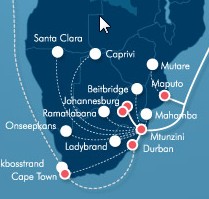The East African submarine cable system SEACOM has added some terrestrial fiber down in South Africa, investing R100M in dark fiber from Dark Fiber Africa as well as the equipment to light it. The fiber will hook up the cable’s landing station on KwaZulu Natal’s coast with two redundant PoPs in Gauteng. Gauteng is not a household name, but it’s two main cities of Johannesburg anbd Pretoria are obviously the target here.
 Initially, ten 10Gbps waves will be lit for 100Gbps, with another 200Gbps expected to come online in the next twelve months. SEACOM’s design capacity is 4.8Tbps, and owning fiber for the terrestrial link gives them greater flexibility in how they bring that bandwidth to bear in the South African marketplace. Of course, the east coast of Africa doesn’t need 4.8Tbps just yet, but the activity in the region has certainly not ebbed much lately.
Initially, ten 10Gbps waves will be lit for 100Gbps, with another 200Gbps expected to come online in the next twelve months. SEACOM’s design capacity is 4.8Tbps, and owning fiber for the terrestrial link gives them greater flexibility in how they bring that bandwidth to bear in the South African marketplace. Of course, the east coast of Africa doesn’t need 4.8Tbps just yet, but the activity in the region has certainly not ebbed much lately.
SEACOM came online just about two years ago amid much fanfare, one of several cables lately bringing oodles of bandwidth to a continent that had always gotten the short end of the communications stick. But it’s the infrastructure on land that is the real work still.
If you haven't already, please take our Reader Survey! Just 3 questions to help us better understand who is reading Telecom Ramblings so we can serve you better!
Categories: Undersea cables






There’s a long way to go, but the work on connecting terrestrial networks to the sub cables has definitely begun. Dark Fibre Africa could bring access to three cables from that Mtunzini landing point. EASSy, SEACOM, and SAFE all have landing points there.
Landlocked countries are starting to get access to sub cables via interconnection agreements with operators in the coastal countries. Operators in Zimbabwe and Malawi are connecting to capacity on both SEACOM and EASSy through interconnection agreements on the border with Mozambique, which has landing stations for both cables in Maputo. And Zimbabwe also has access to SEACOM from the South African side through a border connection at Beitbridge.